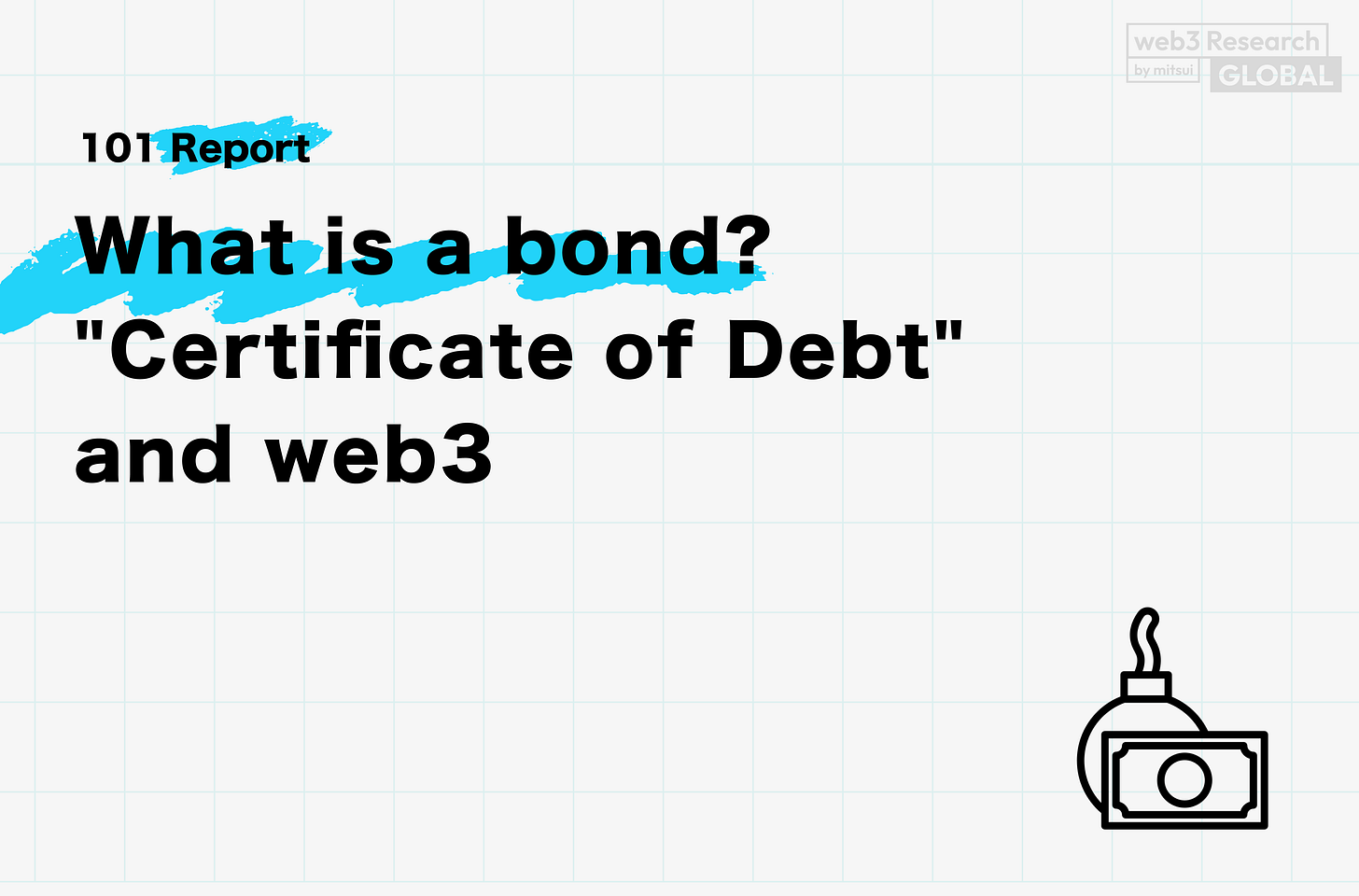What is a bond? - "Certificate of Debt" and web3【Part 2】
A bond is simple when viewed as "a certificate of debt issued by an issuer, such as a corporation or government, when it borrows funds.
Hello.
Mitsui from web3 researcher.
On Saturdays and Sundays at noon, we are bringing you a report on the basics of understanding web3, titled "The Fundamentals of web3".
This week's topic is "Securities and Bonds".
1. Introduction: why bonds are important
2-1. Definition of bonds
2-2.br data-dl-uid="19">2-2. Types of bonds
2-3. Main components of bonds
3-1. Primary and secondary markets
3-2. Inverse correlation between interest rates and bond prices
3-3. Credit Risk and Ratings
4-1. What is bond tokenization?
5-2. Difference between Bonds and DeFi Lending
5-3. Risk and YieldConcepts
6-1. The interface with web3 based on the nature of bonds
6-2. FutureHow will the integration of the bond market and web3 proceed?
6-3. Points to keep in mind throughout the series
Afterword
1. introduction: why bonds are important
In the first part of this article, we discussed the topic "What is a security?"and explained that securities = "financial instruments that represent the right to receive future value or income.There are various securities such as stocks and derivatives, among which "bonds" are very important financial instruments, especially those in which funds are exchanged through the "debt" mechanism.
Bonds can be simply viewed as "something issued by an issuer, such as a corporation or government, when it borrows funds, to prove the nature of its debt.In a sense, it has been used as an "investment instrument that can easily generate stable income" because investors (lenders) can expect future repayment and interest payments.
Meanwhile, in the web3 world, DeFi platforms such as Aave and Compound are increasingly offering "lending and borrowing with crypto assets as collateral," from which many users earn interest income.
"Traditional bonds issued by corporations and governments" and "lending and borrowing in DeFi lending" may seem completely different at first glance, but at the root of both is"Borrowers collect funds and lenders receive interest.
In the second part, we will take a deeper look at how this bond worksThe way "debt" and "credit" are being redefined by web3Let's take a look.
2-1. Definition of a bond
Bondsare "borrowing certificates" issued by issuers such as national governments, municipalities and corporations to investors when they borrow funds.The "Borrowing Certificate" is issued by issuers such as national governments and municipalities.Because it is a loan, the money naturally carries interest and the promise to repay the principal and interest by a set date (redemption date).
Issuer: Entities that borrow money (governments, companies, etc.)
Investors (bondholders): entities that lend money.By purchasing a bond, they earn the right to receive the principal plus interest.
Coupon (interest rate): The surface interest rate of a bond.Interest paid semiannually, annually, etc..
Maturity date: The bond's due date.By this date, the issuer is obligated to repay the borrowed money.
Traditionally, bonds are often considered "safe assets" (low-risk investments).In particular, government bonds (bonds issued by national governments) are considered "extremely unlikely to default," and were commonly held in large quantities by institutional investors and central banks around the world.However, the risk also varies greatly depending on the creditworthiness of the issuer, such as corporate bonds and government bonds of emerging countries.
2-2. Types of Bonds
There are several ways to classify bonds, depending on the issuer, currency, and form of interest rate.Here are some typical examples.
Government Bonds.
Bonds issued by governments to raise funds.Considered the most creditworthy, but may not always be safe in countries with deteriorating fiscal conditions.
Municipal bonds
Issued by local governments such as prefectures and municipalities.They are used for infrastructure development and other purposes.
Company bonds
Issued by a company to raise funds.Interest rates vary depending on the credit risk of the company.
Foreign bonds, samurai bonds, etc.
Foreign bonds: Bonds issued by foreign governments or companies in foreign markets.
Samurai bonds: Bonds issued by foreign companies in Japanese yen.
There are also a number of different issue currencies, such as
Warrant bonds, convertible bonds (CBs)
A bond with the right to be converted into stock, etc.They have characteristics of both equity and bond investments.
Thus, bonds are a very versatile financing tool.Depending on the circumstances of a company or government, interest rate types and redemption periods can be varied to make them more attractive to investors.



